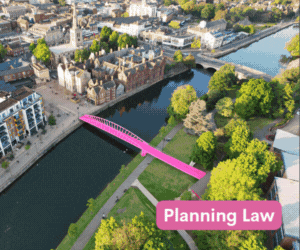Council fails in High Court challenge to grant of planning permission by inspector for mixed use development on 22.45ha site
- Details
Basingstoke and Deane Borough Council has lost a High Court legal action over whether a planning inspector correctly handled the relationship between a planning application and the borough’s development plan.
The council brought the action against the Secretary of State for Levelling Up, Housing and Communities. Developer Bewley Homes was an interested party.
Mr Justice Holgate said in his judgment that Section 70(2) of the Town and Country Planning Act 1990 requires local planning authorities and the Secretary of State to have regard to relevant provisions of the development plan and “to any other material considerations”.
He said Section 38(6) of the Planning and Compulsory Purchase Act 2004 provided that if regard is had to the development plan that determination must be made in accordance with the plan unless material considerations indicate otherwise.
Holgate J said Section 38(6) has two limbs. The first requires applications to be determined in accordance with the development plan, except where, under the second limb, "material considerations indicate otherwise."
Basingstoke and Deane argues that whether or not the policies of a development plan were out-of-date was legally irrelevant to the first limb as that consideration may only be taken into account under the second limb.
He said the nub of the council’s case was that whether what is proposed in a planning application accords with a development plan depends upon whether it accords with what is written in those policies of the plan which are relevant to the proposal.
The council went on to argue that where a proposal accords with what is written in some of those policies but not others, the application of the first limb of s.38(6) depends upon whether that proposal accords with the plan read as a whole.
Basingstoke and Deane argued that whether what is written in the development plan is up-to-date or out-of-date has no bearing on whether what is proposed accords with what is written in the plan when read as a whole.
Holgate J said: “Parliament did not enact s.38(6) so as to read ‘the determination must be made in accordance with what is written in the plan …’.
“There is no case law to support the claimant's attempt to read those additional words into the statute.”
The council though maintained that the datedness of a local plan policy is not relevant to the judgment which a decision-maker makes under the first limb of s.38(6),
Bewley Homes had applied to build up to 188 homes and various infrastructure and amenities on a site that was not allocated and does not lie within any settlement boundary.
The council rejected this but on appeal an inspector concluded that the proposal would accord with a number of policies in the plan relating to affordable housing, infrastructure, transport, biodiversity, nature conservation, though conflicted with spatial policies.
Bewley, the council and the inspector agreed that the spatial distribution policies for housing and the settlement boundaries in the development plan were out-of-date and housing delivery over the current local plan period from 2011-22 had been 769 dwellings less than the amount required.
The spatial strategy was not delivering the housing requirement, and the inspector concluded that both those policies and some others meant that taken as a whole the plan was out-of-date.
Basingstoke and Deane argued that the inspector made an error of law by taking into account his finding that the spatial distribution policies were out-of-date when he decided that the proposal was in accordance with the development plan as a whole.
Holgate J said: ”In deciding whether the proposal accorded with the development plan as a whole, it was logical and consistent with the application of [spatial] policy in this case for the inspector to take into account the out-of-datedness of the spatial strategy. Indeed, to have ignored that factor would have been internally inconsistent and would have failed to apply the development plan as a whole.
“For these reasons alone, the challenge must fail.”
Holgate J concluded: ”In this case, unlike others, the inspector found that the proposal would cause relatively limited harm and that the conflict with the spatial strategy attracted only limited weight, given its failure to achieve a key objective of the development plan.
“The inspector found that the benefits of the scheme clearly outweighed the harms. He was entitled to reach those conclusions. Here the [council] plainly lost the appeal on the planning merits in a way which cannot be impugned. This challenge has no legal merit at all.”
Mark Smulian
Contracts & Procurement Lawyer
Senior Lawyer - Contracts & Commercial
Senior Lawyer - Contracts & Commercial
Lawyer - Property
Trust Solicitor (Employment & Contract Law)
Locums
Poll






































